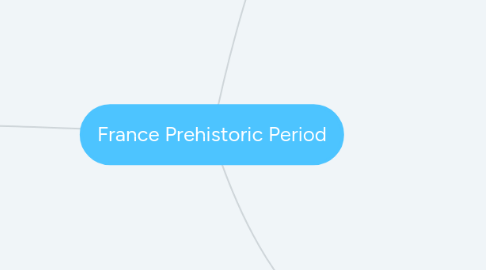
1. Definition of Prehistory
1.1. Refers to the period of time before civilization and writing. Or before humans develop and began writing things down.
2. Stone Age Period 8700 BCE and 2000 BCE
2.1. Paleolithic Period 35,000 to 8300 BCE
2.1.1. Stone tools discovered at Lézignan-la-Cèbe prove that early humans were present in France at least 1.57 million years ago.
2.1.2. In France there is also a cave art from the paleolithic period,
2.1.3. The tools were made from stone
2.1.3.1. Hammer stone, Flake Tool
2.2. Mesolithic Period
2.2.1. Men and women developed strategies for food acquisition, to take advantage of all animals and plants resources.
2.3. Neolithic Period c. 4500 BC–1700 BC
2.3.1. They grew corps, settled locations, and kept animals.
2.3.2. They learned how to construct dwellings, mostly of wood but then also with stone.
2.3.3. They choose a suitable location, and then plant corps
2.3.4. Tools
2.3.4.1. Stone axes, blades, arrowheads, ring stone, sickle, plough, harpoon, muller
2.3.4.2. The tools are mostly for hunting.
2.3.5. They also do trading, a polished stone bracelet was founded in a grave in the VSG-settlement of Jablin Les-Longues-Raies was made of amphibolite from the island of Groix in southern Morbihan, this proves trade with local Mesolithic communities.
3. Metal Age Period
3.1. Copper age 4500 to 2200 b.c.e
3.1.1. A transitional age from the Neolithic to the Bronze Age
3.1.2. Beaker culture and Seine-Oise-Marne culture
3.1.3. The seine-Oise-Marne culture made graves from stones
3.1.4. Tools
3.1.4.1. Copper axes
3.1.4.2. Arrows
3.2. Bronze age - C. 1000–750 b.c.e
3.2.1. The wooden houses are small, presumably for nuclear family units, and settlements are limited and short-lived.
3.2.2. The landscapes were highly organized,
3.2.3. Tools and jewelry
3.2.3.1. Solid dagger, found in Les Taburles and Les Ruscats
3.2.3.2. Bronze necklace, Penne Tarn
3.2.3.3. Bronze cup, bowls, and jugs
3.2.4. They have dense occupations and industrial activities. They made houses and roads.
3.2.5. The beaker culture, Its spread has been one of the central questions of the migrationism vs. diffusionism debate in 20th-century archaeology, variously described as due to migration, possibly of small groups of warriors, craftsmen or traders, or due to the diffusion of ideas and object exchange
3.3. Iron age c. 700 to 500 BCE
3.3.1. The tools were much more advance made from Iron and adoption of ironworking, but bronze were not vanquished immediately.
3.3.2. Tools and weapons
3.3.2.1. Long iron swords
3.3.2.2. Iron dagger
3.3.2.3. Iron horse harness
3.3.3. Burials of wealth objects to accompany the dead to demonstrate their social power.
3.3.4. France was founding city of Massaila, now known as Marseille.
3.3.5. They found gold and silver, which is made into jewelry.
3.3.6. They also have coin production, iron, glass, and other industries.

